Top Rankings
Concord School District ranks among the top 20% of public school district in New Hampshire for:
Category
Attribute
Diversity
Most diverse schools (Top 1%)
Community Size
Largest student body (number of students) (Top 1%)
For the 2025 school year, there are 3 public preschools serving 1,046 students in Concord School District. This district's average pre testing ranking is 3/10, which is in the bottom 50% of public pre schools in New Hampshire.
Public Preschools in Concord School District have an average math proficiency score of 32% (versus the New Hampshire public pre school average of 44%), and reading proficiency score of 37% (versus the 47% statewide average).
Minority enrollment is 24% of the student body (majority Black and Asian), which is more than the New Hampshire public preschool average of 16% (majority Hispanic).
Overview
This School District
This State (NH)
# Schools
7 Schools
149 Schools
# Students
3,932 Students
39,813 Students
# Teachers
330 Teachers
3,470 Teachers
Student : Teacher Ratio
12:1
12:1
District Rank
Concord School District, which is ranked within the bottom 50% of all 189 school districts in New Hampshire (based off of combined math and reading proficiency testing data) for the 2021-2022 school year.
The school district's graduation rate of 90% has increased from 87% over five school years.
Overall District Rank
#159 out of 189 school districts
(Bottom 50%)
(Bottom 50%)
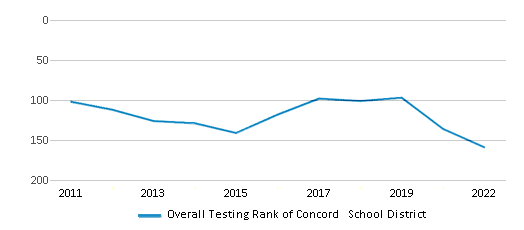
Math Test Scores (% Proficient)
29%
40%
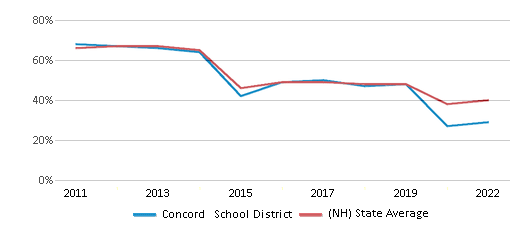
Reading/Language Arts Test Scores (% Proficient)
42%
51%
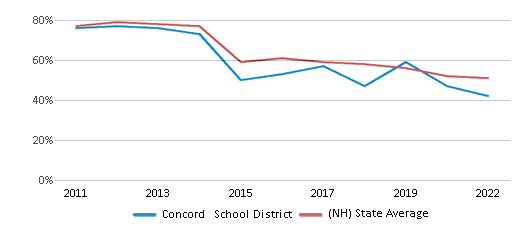
Science Test Scores (% Proficient)
29%
36%
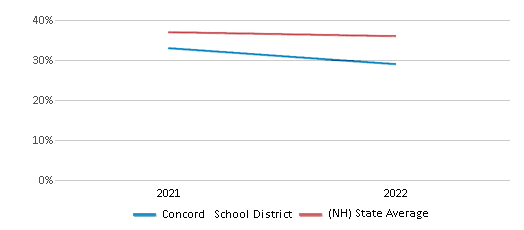
Graduation Rate
90%
88%
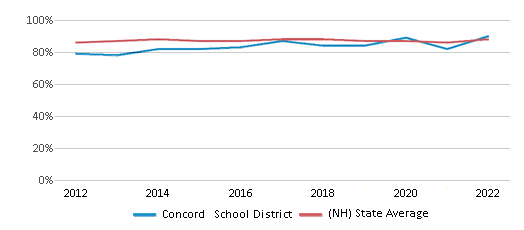
Students by Ethnicity:
Diversity Score
0.39
0.29
# American Indian Students
16 Students
71 Students
% American Indian Students
n/a
n/a
# Asian Students
214 Students
952 Students
% Asian Students
6%
3%
# Hispanic Students
169 Students
2,514 Students
% Hispanic Students
4%
6%
# Black Students
359 Students
807 Students
% Black Students
9%
2%
# White Students
3,055 Students
33,448 Students
% White Students
78%
84%
# Hawaiian Students
1 Student
29 Students
% Hawaiian Students
n/a
n/a
# Two or more races Students
119 Students
1,992 Students
% of Two or more races Students
3%
5%
Students by Grade:
# Students in PK Grade:
116
4,442
# Students in K Grade:
245
6,330
# Students in 1st Grade:
240
6,046
# Students in 2nd Grade:
293
6,232
# Students in 3rd Grade:
286
5,421
# Students in 4th Grade:
261
5,076
# Students in 5th Grade:
270
3,284
# Students in 6th Grade:
241
1,218
# Students in 7th Grade:
268
887
# Students in 8th Grade:
265
877
# Students in 9th Grade:
339
-
# Students in 10th Grade:
348
-
# Students in 11th Grade:
367
-
# Students in 12th Grade:
393
-
# Ungraded Students:
-
-
District Revenue and Spending
The revenue/student of $23,668 is higher than the state median of $22,075. The school district revenue/student has stayed relatively flat over four school years.
The school district's spending/student of $21,848 is higher than the state median of $21,293. The school district spending/student has stayed relatively flat over four school years.
Total Revenue
$93 MM
$3,646 MM

Spending
$86 MM
$3,517 MM
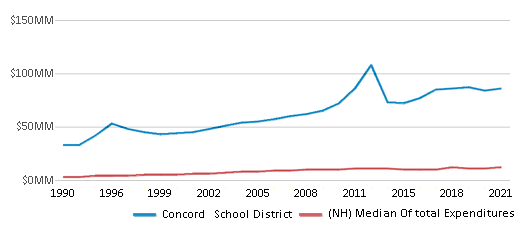
Revenue / Student
$23,668
$22,075
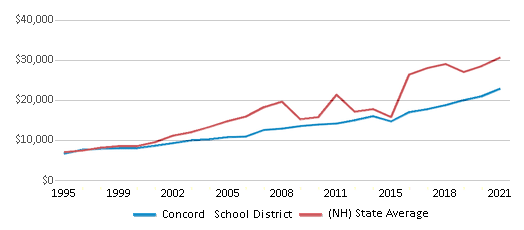
Spending / Student
$21,848
$21,293
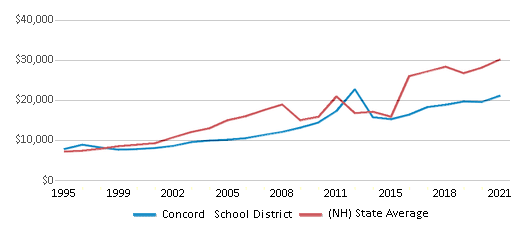
Best Concord School District Public Preschools (2025)
School
(Math and Reading Proficiency)
(Math and Reading Proficiency)
Location
Grades
Students
Rank: #11.
Abbot-downing School
(Math: 30-34% | Reading: 40-44%)
Rank:
Rank:
3/
Bottom 50%10
152 South St.
Concord, NH 03301
(603) 225-0827
Concord, NH 03301
(603) 225-0827
Grades: PK-5
| 345 students
Rank: #22.
Beaver Meadow School
(Math: 30-34% | Reading: 30-34%)
Rank:
Rank:
2/
Bottom 50%10
40 Sewalls Fall Rd.
Concord, NH 03301
(603) 225-0853
Concord, NH 03301
(603) 225-0853
Grades: PK-5
| 362 students
Rank: n/an/a
53 South Curtisville Road
Concord, NH 03301
(603) 225-0830
Concord, NH 03301
(603) 225-0830
Grades: PK-2
| 339 students
Recent Articles

Sexual Harassment at Age 6: The Tale of a First Grade Suspension
A six-year old in Aurora, Colorado, was suspended after singing an LMFAO song to a little girl in his class and reportedly “shaking his booty.” We look at the case and the sexual harassment problem in public schools today.

How Scaffolding Could Change the Way Your Child Learns
This article explores the concept of instructional scaffolding, a teaching method that enhances learning by breaking down complex tasks into manageable parts. It highlights how scaffolding supports students in developing critical thinking skills and becoming more independent learners. The article discusses the benefits of scaffolding, including improved engagement and reduced anxiety, and provides strategies for its implementation across various educational levels.

February 05, 2025
Understanding the U.S. Department of Education: Structure, Impact, and EvolutionWe explore how the Department of Education shapes American education, from its cabinet-level leadership to its impact on millions of students, written for general audiences seeking clarity on this vital institution.





